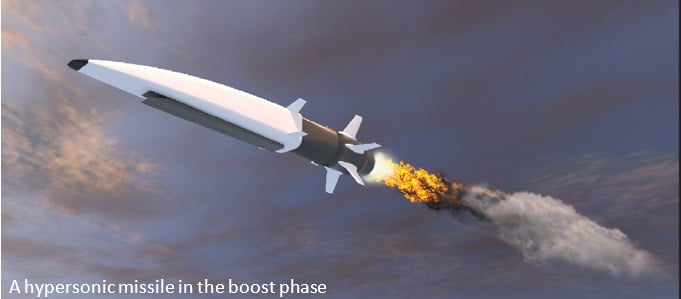An adversary launches hypersonic missiles at a carrier group in the Pacific. Booster rockets carry the warheads—hypersonic glide vehicles— to the edge of space. But before the boosters can release their payloads, they are suddenly attacked by a swarm of small satellites. The satellites smash into the boosters, destroying them.
The technology needed for such a defense against hypersonic missiles is now available, and it is cost-effective. By leveraging dramatic cost reductions in space launch, as well as a range of technologies currently used in commercial endeavors—from Starlink to Uber—the joint forces have new opportunities to reduce the hypersonic threat. And satellite swarms can also be a powerful defense against conventional ballistic missiles.
Hitting Hypersonics At The Edge of Space
The Defense Department is improving its ability to intercept hypersonics in the glide phase, using both conventional and hypersonic missiles. But that remains an extremely complex task, given the glide vehicles’ speed—more than a mile a second—as well as their formidable maneuverability and low flight paths.
The idea behind swarms of small satellites is to destroy hypersonic missiles when they’re most vulnerable— when they’re in the boost phase, on a predictable trajectory like a conventional missile, and are easier to detect and track. Although it’s difficult for land-and-sea-based defensive weapons to get to the booster rockets before they release their warheads, swarms of small satellites are in a much better position to intercept them. The satellites can track the hypersonic missiles from the time they’re launched, and can be there when the boosters reach the edge of space. The same approach can be used to intercept an adversary’s conventional ballistic missiles throughout most of their trajectories.
How The Swarms Work
A swarm might have thousands of small satellites in low-earth orbit, at the edge of space, something that SpaceX’s Starlink constellation has shown to be both technologically and economically feasible. There are now about 5,000 small Starlink satellites in low-earth orbit, and SpaceX has received government approval to increase that number to 12,000.
The satellites in the DoD swarm would connect with each other through an “internet in space,” a network backbone created by another set of satellites. With this approach, all of the satellites in the swarm have the same information, so that if one satellite spots a missile launch, they all see it. It’s similar to the way Uber works. Each Uber driver serves as a node in a network, providing information to help create a common operating picture.
Another advantage of the swarm’s network is that it is largely protected against jamming. While an adversary might be able to jam a handful of the small satellites, that would have no effect on the overall network. This is another way that the swarm is similar to Uber’s peer-to-peer network: if an Uber driver accepts a rider and then drops out, the system automatically looks for another driver. In this sense, the swarm’s network is
self-healing.
Advanced Autonomy
With the DoD swarm, the network backbone would allow the small satellites to coordinate their efforts autonomously, with the help of AI. For example, if the swarm spots 20 booster rockets, the satellites would decide among themselves which satellites will try to intercept which boosters. They might take a shotgun approach, with five or ten satellites, for example, trying to hit each booster. Once one of the satellites succeeds, the others rejoin the swarm, ready to go after other boosters.
The satellites can also aid land- and sea-based defensive systems. While much of the swarm might be intercepting boosters, other satellites might use lasers to illuminate glide vehicles that make it through.
The artificial intelligence that can provide the small satellites with these and other advanced autonomous capabilities is currently available. And in fact, those capabilities are akin to the ones that will help unmanned surface, undersea and aerial vehicles achieve their own autonomous missions.
Cost-Effective Deterrence
One challenge facing swarms is that, in the booster phase, hypersonic missiles look the same as conventional ballistic missiles. So, the satellites would have to go after every missile— they can’t wait to see which ones are carrying hypersonic glide vehicles. This means that if an adversary launches hundreds of missiles—both conventional and hypersonic—the swarm may be unlikely to get them all. However, the adversary would not know which of its missiles will get through and which ones will be destroyed, potentially leaving open a huge response capability. In this way, satellite swarms can act as a deterrent.
As SpaceX has demonstrated with its Starlink constellation, putting thousands of small satellites into orbit is cost-effective. One reason is that multiple small satellites can be part of a launch, which accounts for a major portion of the cost of a satellite. The swarm’s small satellites are also less costly to build, operate, and maintain.
Hypersonic missiles pose a new kind of threat, requiring new kinds of defenses. One such defense is a satellite swarm that targets the hypersonics where they are most vulnerable—at the edge of space.
Lt. Gen. Trey Obering (obering_trey@bah.com) is a Senior Executive Advisor at Booz Allen, specializing in space and missile defense. He is the former Director of the Missile Defense Agency.
Vito Partipilo (partipilo_vito@bah.com) is a senior lead technologist at Booz Allen specializing in space missile defense architecture modeling and simulation. He is a chief engineer supporting the Space Sensing Command at Los Angeles Air Force Base.





